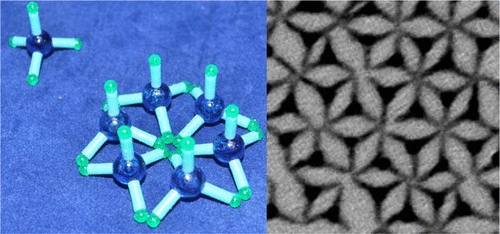Our official English website, www.x-mol.net, welcomes your feedback! (Note: you will need to create a separate account there.)
Programmed Self-Assembly of Branched Nanocrystals with an Amphiphilic Surface Pattern
ACS Nano ( IF 17.1 ) Pub Date : 2017-09-08 00:00:00 , DOI: 10.1021/acsnano.7b04719 Yuki Taniguchi 1 , Muhammad Adli Bin Sazali 2 , Yusei Kobayashi 2 , Noriyoshi Arai 2 , Tsuyoshi Kawai 1 , Takuya Nakashima 1
ACS Nano ( IF 17.1 ) Pub Date : 2017-09-08 00:00:00 , DOI: 10.1021/acsnano.7b04719 Yuki Taniguchi 1 , Muhammad Adli Bin Sazali 2 , Yusei Kobayashi 2 , Noriyoshi Arai 2 , Tsuyoshi Kawai 1 , Takuya Nakashima 1
Affiliation

|
Site-selective surface modification on the shape-controlled nanocrystals is a key approach in the programmed self-assembly of inorganic colloidal materials. This study demonstrates a simple methodology to gain self-assemblies of semiconductor nanocrystals with branched shapes through tip-to-tip attachment. Short-chained water-soluble cationic thiols are employed as a surface ligand for CdSe tetrapods and CdSe/CdS core/shell octapods. Because of the less affinity of arm-tip to the surface ligands compared to the arm-side wall, the tip-surface becomes uncapped to give a hydrophobic nature, affording an amphiphilic surface pattern. The amphiphilic tetrapods aggregated into porous agglomerates through tip-to-tip connection in water, while they afforded a hexagonally arranged Kagome-like two-dimensional (2D) assembly by the simple casting of aqueous dispersion with the aid of a convective self-assembly mechanism. A 2D net-like assembly was similarly obtained from amphiphilic octapods. A dissipative particle dynamics simulation using a planar tripod model with an amphiphilic surface pattern reproduced the formation of the Kagome-like assembly in a 2D confined space, demonstrating that the lateral diffusion of nanoparticles and the firm contacts between the hydrophobic tips play crucial roles in the self-assembly.
中文翻译:

具有两亲性表面图案的支化纳米晶体的程序化自组装
在形状可控的纳米晶体上进行定点选择性表面修饰是无机胶体材料程序自组装的关键方法。这项研究演示了一种简单的方法,可以通过尖端到尖端的附着获得具有分支形状的半导体纳米晶体的自组装。短链水溶性阳离子硫醇用作CdSe四足动物和CdSe / CdS核/壳八足动物的表面配体。由于与手臂侧壁相比,手臂尖端对表面配体的亲和力较小,因此尖端表面变得不封端,从而具有疏水性,从而提供了两亲性的表面图案。两亲四足动物通过在水中从尖端到尖端的连接而聚集成多孔团聚体,而他们通过对流自组装机制,通过简单浇铸水分散体,提供了六角形排列的类似Kagome的二维(2D)组装。类似地从两亲八足动物获得2D网状组装体。使用具有两亲表面图案的平面三脚架模型进行的耗散粒子动力学模拟,再现了二维封闭空间中类似Kagome的组件的形成,表明纳米粒子的横向扩散和疏水性尖端之间的牢固接触在该过程中起着至关重要的作用。自组装。
更新日期:2017-09-08
中文翻译:

具有两亲性表面图案的支化纳米晶体的程序化自组装
在形状可控的纳米晶体上进行定点选择性表面修饰是无机胶体材料程序自组装的关键方法。这项研究演示了一种简单的方法,可以通过尖端到尖端的附着获得具有分支形状的半导体纳米晶体的自组装。短链水溶性阳离子硫醇用作CdSe四足动物和CdSe / CdS核/壳八足动物的表面配体。由于与手臂侧壁相比,手臂尖端对表面配体的亲和力较小,因此尖端表面变得不封端,从而具有疏水性,从而提供了两亲性的表面图案。两亲四足动物通过在水中从尖端到尖端的连接而聚集成多孔团聚体,而他们通过对流自组装机制,通过简单浇铸水分散体,提供了六角形排列的类似Kagome的二维(2D)组装。类似地从两亲八足动物获得2D网状组装体。使用具有两亲表面图案的平面三脚架模型进行的耗散粒子动力学模拟,再现了二维封闭空间中类似Kagome的组件的形成,表明纳米粒子的横向扩散和疏水性尖端之间的牢固接触在该过程中起着至关重要的作用。自组装。


























 京公网安备 11010802027423号
京公网安备 11010802027423号